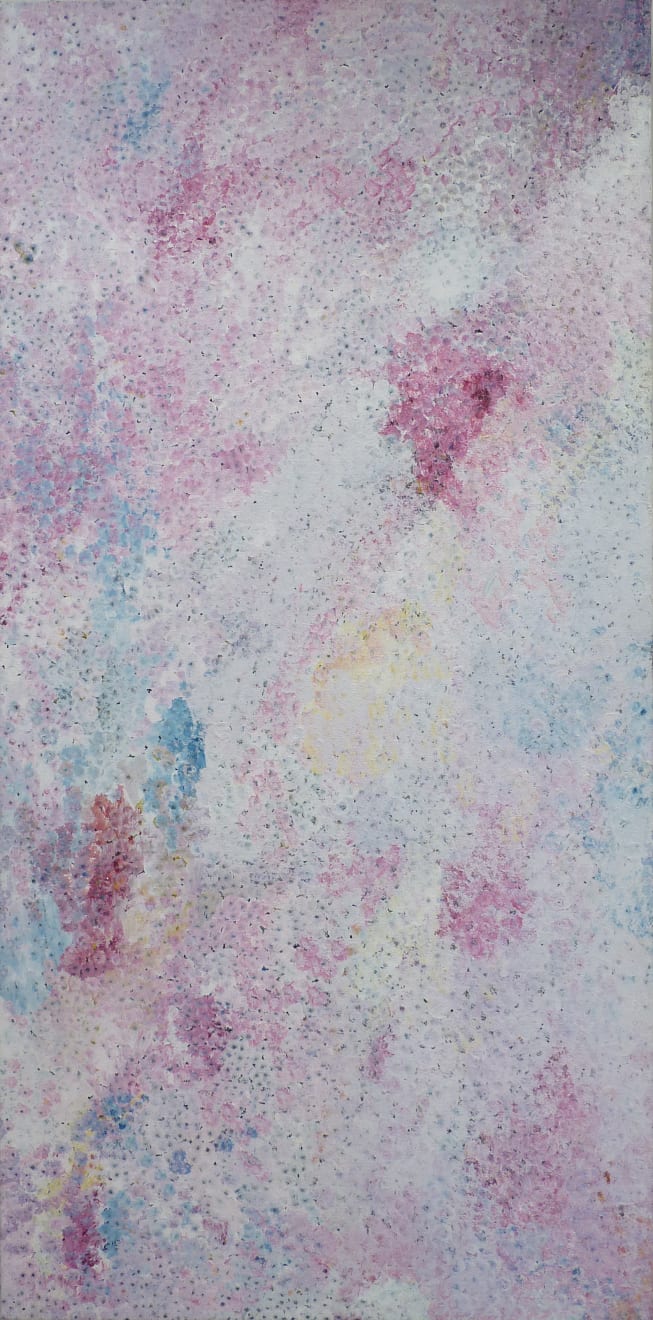
Kathleen Kngale Camel Camp, Utopia, NT, Australia, b. 1934
Anekwetj - Bush Plum, 2009
Acrylic on canvas
121cm x 80cm
£ 3,950.00
This is a magnificent example of Kathleen Kngale's art. Kathleen's celebrated canvasses hang in the collections of the National Gallery of Australia, the National Gallery of Victoria, the Queensland Art...
This is a magnificent example of Kathleen Kngale's art. Kathleen's celebrated canvasses hang in the collections of the National Gallery of Australia, the National Gallery of Victoria, the Queensland Art Gallery, corporate, and private collectors.
Kathleen's final flourish of a white dotted overlay across the canvas represents the sundried leaves, seeds, husks and grasses of Arlperre, and allows beautiful pale shades to radiate across the surface of the painting. This is her expression of her country and its meaning.
Arlperre is a most significant "country" on Utopia Station west of Delmore Downs. The Kngale and Kemarre women custodians who paint Arlperre, largely focus on the Anekwetj (pron."Anookitja") a Conkerberry, and another fruit called "argia" both of which are simply called "bush plum". The Anekwetj is the smaller fruit, found on a bushy shrub with small bright green leaves and small white flowers, thriving in groves in richer soil types. It is somewhat like a firm dark grape and the seed is spat out. The Argia plum grows on a large tree that is often found near groves of Mulga. When shaken, the plum drops to the ground.
These bush plums abound over the vast flood-out area of Arlperre on average every one in seven years when the Sandover River floods after huge storms. In traditional times this event was of great relief and celebration. Kathleen's treatment of this bush plum theme derives from her long memory of survival, particularly the hard years of drought, the internalised anticipation of rain, and belief that ceremony would help bring the rain and flush of bush food. Colours underlying the surface represent the different degrees of ripeness of the plums, with the purple being the most suitable indicator for eating.
Knowing when to harvest, how to select, and how to consume this food source is of major importance to the food gatherer of traditional times, especially when nutrient rich food was difficult to source.
Kathleen's final flourish of a white dotted overlay across the canvas represents the sundried leaves, seeds, husks and grasses of Arlperre, and allows beautiful pale shades to radiate across the surface of the painting. This is her expression of her country and its meaning.
Arlperre is a most significant "country" on Utopia Station west of Delmore Downs. The Kngale and Kemarre women custodians who paint Arlperre, largely focus on the Anekwetj (pron."Anookitja") a Conkerberry, and another fruit called "argia" both of which are simply called "bush plum". The Anekwetj is the smaller fruit, found on a bushy shrub with small bright green leaves and small white flowers, thriving in groves in richer soil types. It is somewhat like a firm dark grape and the seed is spat out. The Argia plum grows on a large tree that is often found near groves of Mulga. When shaken, the plum drops to the ground.
These bush plums abound over the vast flood-out area of Arlperre on average every one in seven years when the Sandover River floods after huge storms. In traditional times this event was of great relief and celebration. Kathleen's treatment of this bush plum theme derives from her long memory of survival, particularly the hard years of drought, the internalised anticipation of rain, and belief that ceremony would help bring the rain and flush of bush food. Colours underlying the surface represent the different degrees of ripeness of the plums, with the purple being the most suitable indicator for eating.
Knowing when to harvest, how to select, and how to consume this food source is of major importance to the food gatherer of traditional times, especially when nutrient rich food was difficult to source.